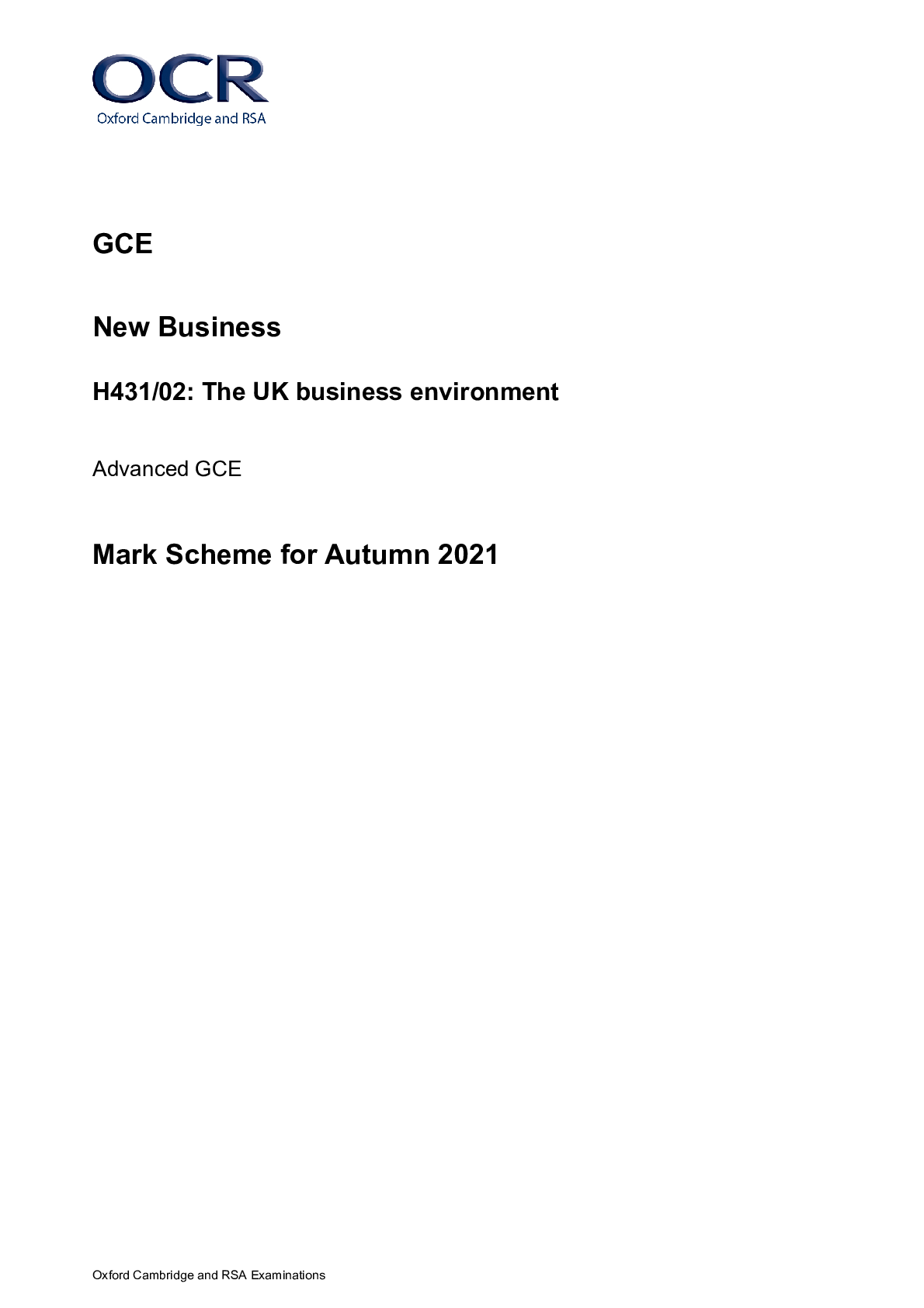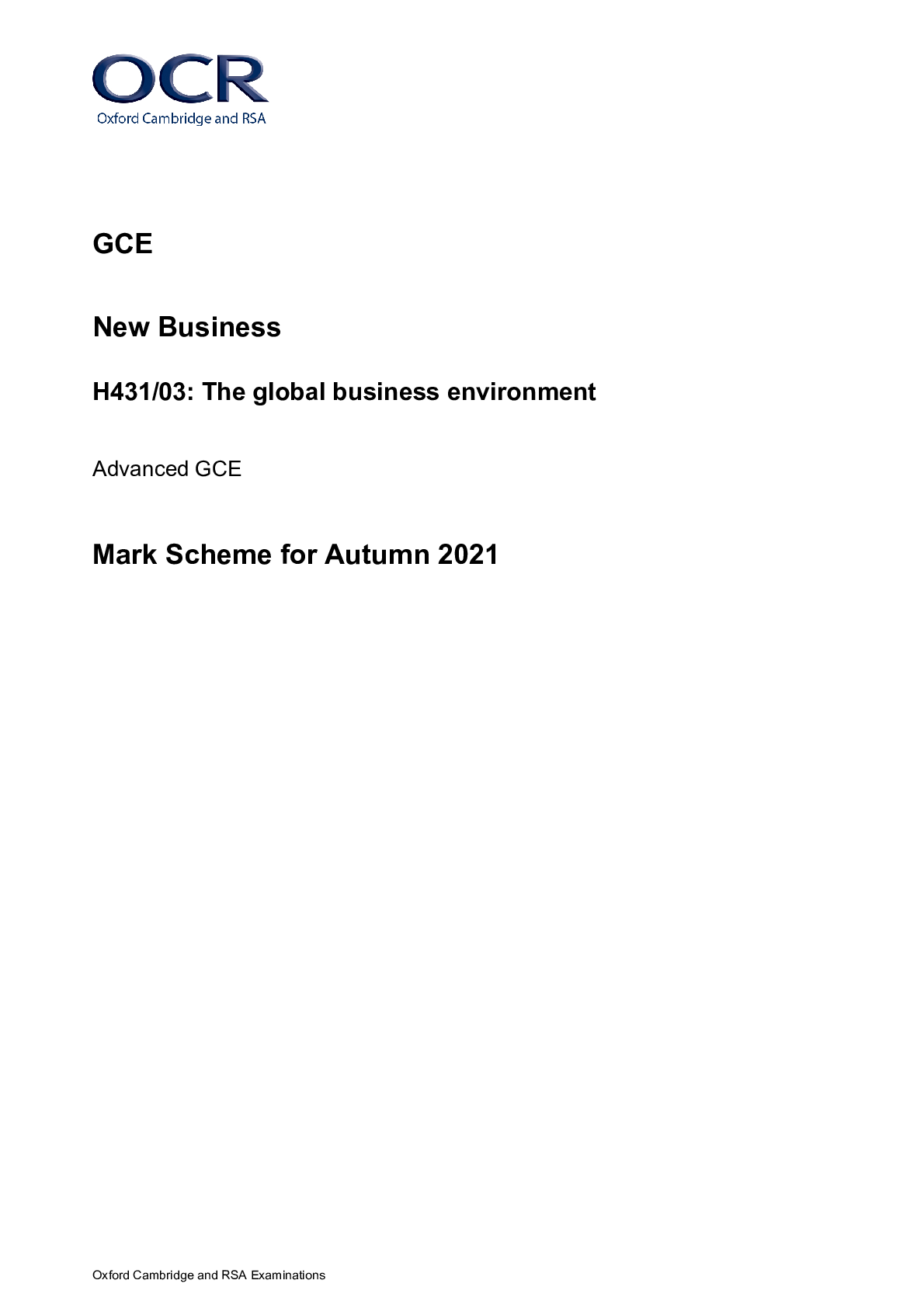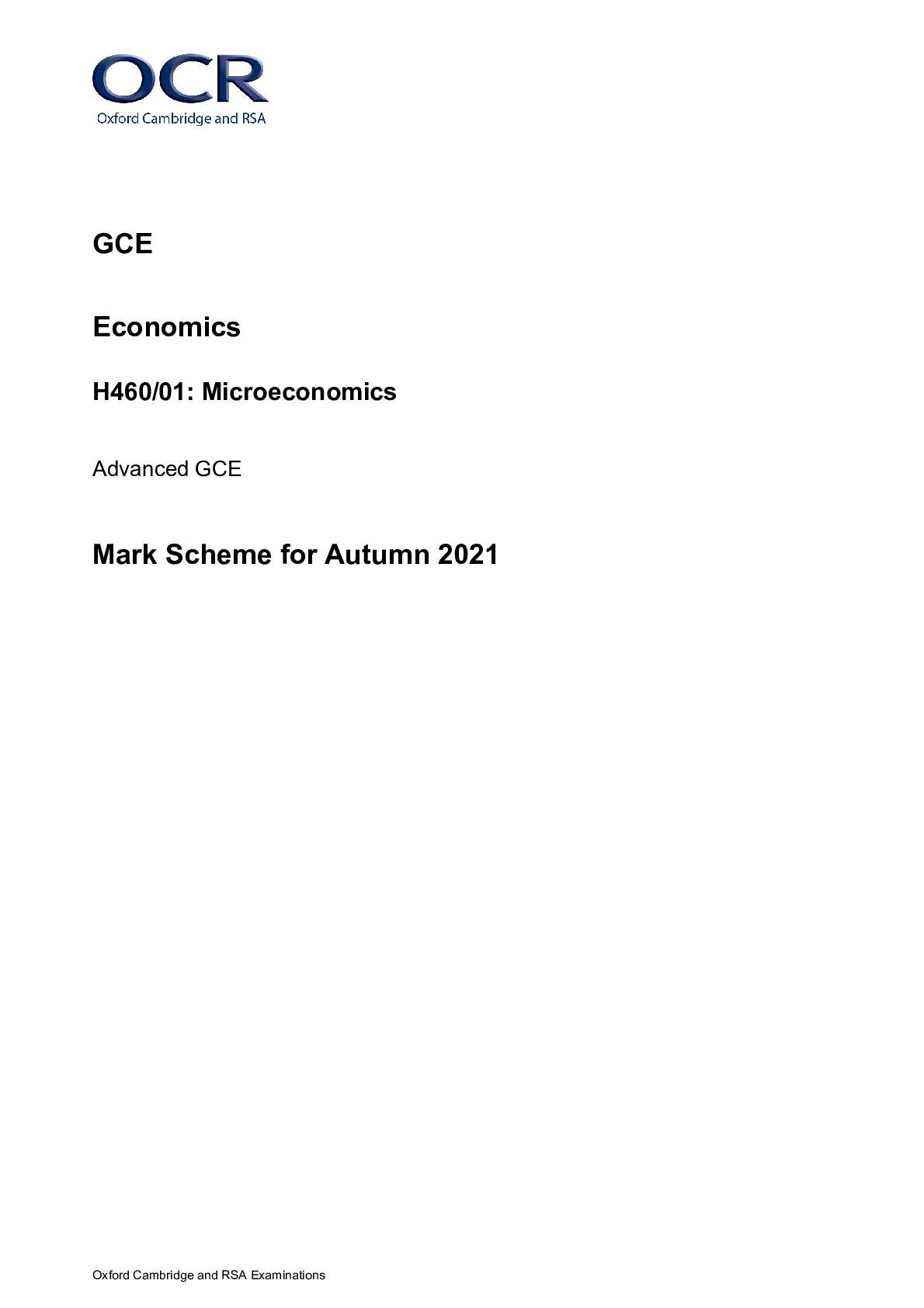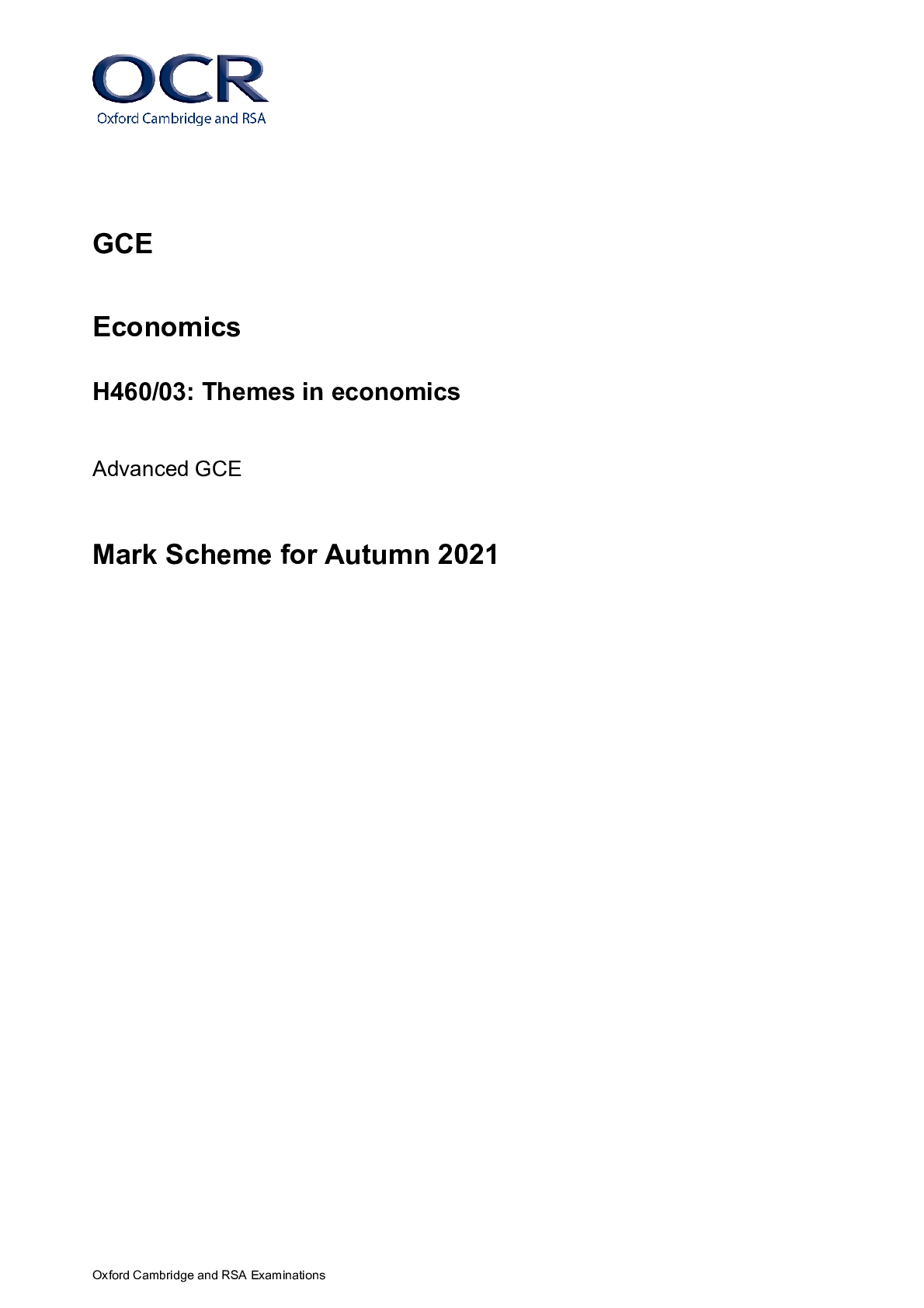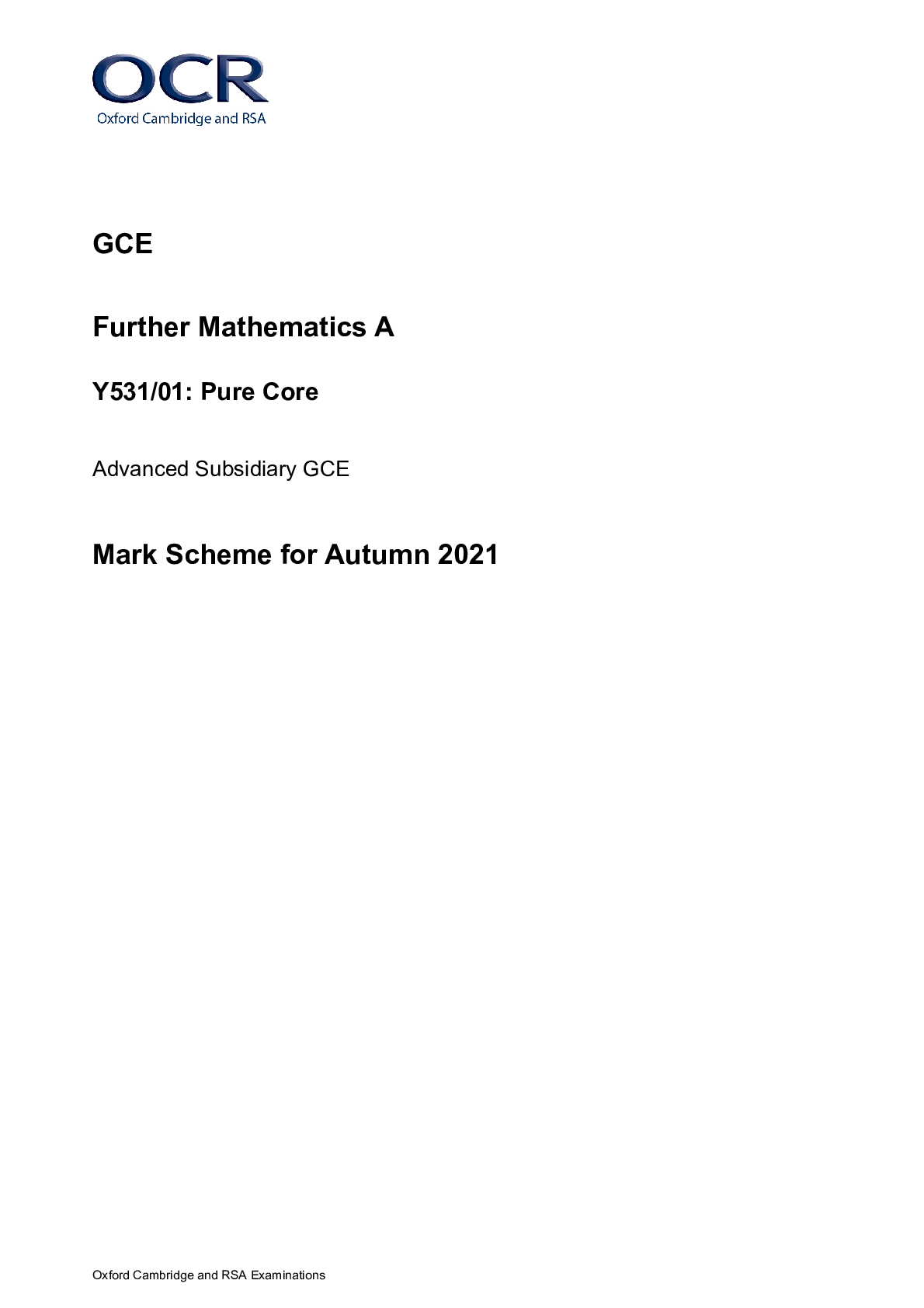Religious Studies > MARK SCHEME > GCE Religious Studies H573/03: Developments in Christian thought Advanced GCE Mark Scheme for Autumn (All)
GCE Religious Studies H573/03: Developments in Christian thought Advanced GCE Mark Scheme for Autumn 2021
Document Content and Description Below
GCE Religious Studies H573/03: Developments in Christian thought Advanced GCE Mark Scheme for Autumn 2021 Oxford Cambridge and RSA Examinations GCE Religious Studies H573/03: Developments ... in Christian thought Advanced GCE Mark Scheme for Autumn 2021Oxford Cambridge and RSA Examinations OCR (Oxford Cambridge and RSA) is a leading UK awarding body, providing a wide range of qualifications to meet the needs of candidates of all ages and abilities. OCR qualifications include AS/A Levels, Diplomas, GCSEs, Cambridge Nationals, Cambridge Technicals, Functional Skills, Key Skills, Entry Level qualifications, NVQs and vocational qualifications in areas such as IT, business, languages, teaching/training, administration and secretarial skills. It is also responsible for developing new specifications to meet national requirements and the needs of students and teachers. OCR is a not-for-profit organisation; any surplus made is invested back into the establishment to help towards the development of qualifications and support, which keep pace with the changing needs of today’s society. This mark scheme is published as an aid to teachers and students, to indicate the requirements of the examination. It shows the basis on which marks were awarded by examiners. It does not indicate the details of the discussions which took place at an examiners’ meeting before marking commenced. All examiners are instructed that alternative correct answers and unexpected approaches in candidates’ scripts must be given marks that fairly reflect the relevant knowledge and skills demonstrated. Mark schemes should be read in conjunction with the published question papers and the report on the examination. © OCR 20212 Indicative content – Responses might include: Guidance 1. Critically assess Augustine's teaching that original sin is the reason why humans lack free will. AO1 Candidates may demonstrate knowledge and understanding through the use of some of the following ideas: • Augustine argued that before the Fall humans had free will and used it to be obedient to God and to be in harmony with each other as friends and with the natural world • the Fall was caused by the will desiring power and knowledge for itself; this precipitated the evil act which led to God’s punishment of Adam and Eve their expulsion from Eden and lack of freedom • according to Augustine’s interpretation, the Fall altered the human-God relationship completely; humans were now in a rebellious state in which the divided will was now unable to act freely, fettered by many kinds of desires (concupiscence), especially lust • in this state humans don’t choose to sin but are prone to sin; they prefer falsehoods to truths and their own welfare to the good of others. AO2 Candidates may demonstrate evaluation and analysis through the use of some of the following arguments. • Some candidates might argue that Augustine’s teaching on original sin is the reason why humans lack free will because: o concupiscence is uncontrollable and an urge shared by all humans and so this arguably removes human choice o humans have lost free will through the fact that they cannot control the reality of original sin in their lives; this original sin is that passed on seminally, starting with the loins of Adam o (as suggested by many psychologists) humans do not choose their characteristics freely – there are other influences in play; psychologists may have simply misidentified where this lack of freedom comes from o in the same way that human lack of control is seen in lust (e.g. the difference in relations between Adam and Eve pre- and post-Fall), human lack of freedom is evident in the world around us. • Some candidates might argue that Augustine’s teaching on original sin is not the reason why humans lack free will because: o they do not lack free will but require God’s grace to overcome the challenge of original sin o the lack of free will comes from other sources – e.g. genes, psychological or sociological influences o original sin does not override free will; it means that we have additional burdens to overcome. Candidates might make reference to Augustine’s suggestion that we need a forceful political authority to reign us in or to his writing on the will being half-wounded3 Indicative content – Responses might include: Guidance o while the teaching on original sin is valid, because Genesis stories are not to be taken literally, any lack of freedom cannot come from original sin. • Some candidates may combine these views and argue that: o traditional Christian teaching on atonement and God’s grace removes the punishment of original sin and leaves humans free to make their own moral choices. Some form of free will is not only possible but necessary in order to strive towards goodness.4 Indicative content – Responses might include: Guidance 2. Assess the view that Christians should obey moral commands from the Bible and nowhere else. AO1 Candidates may demonstrate knowledge and understanding through the use of some of the following ideas: • the Bible is traditionally understood to be the revealed word of God and therefore has divine authority; it is therefore the primary source of moral commands for Christians to follow • the Bible is a witness to God’s word through the inspiration of its writers and prophets and so as St Paul writes (2 Timothy 3:16) all words of scripture are God-‘breathed’ • the Bible is the primary source of knowledge about Jesus Christ and his moral teaching, notably in the Sermon on the Mount on inner purity, the new commandment to love one another and to love one’s enemies • the Bible illustrates through countless examples how Christians should live according to God’s special covenant relationship established in the Old Testament (notably the Decalogue) and renewed in the New Testament. Examples show how some fall far short of the covenant ideal, whilst others have had to struggle and suffer to achieve it. • other moral commands derived through reason or general Christian principles are not just secondary, but irrelevant compared to biblical commands. AO2 Candidates may demonstrate evaluation and analysis through the use of some of the following arguments. • Some candidates might argue that Christians should obey the moral commands of the Bible and nowhere else because: o if God all is all powerful, all loving and all knowing, then what He commands will necessarily be good, even if this may not seem so to humans. Christians therefore have a duty to obey o biblical passages which may appear to conflict with each other require Christians to discern what their deeper meanings are and act on them in good faith o human sinfulness means that reason is insufficient to discern from natural law or conscience alone what is morally good o the biblical narrative demonstrates how God’s commands have been obeyed in the past and therefore how they can continue to be imitated and obeyed by Christians today. o other forms of moral authority are deficient and subject to human error in reasoning and selfish motives. Candidates might examine issues with the conscience or make Responses should address the question rather than listing examples of commands from (or not from) the Bible.5 Indicative content – Responses might include: Guidance reference to specific examples of reasons why Church authority might be questioned. • Some candidates might argue that Christians do not need to obey moral commands of the Bible and nowhere else because: o many Christian traditions teach that knowing what is morally good/bad is also to be discerned through reason and conscience o the Bible cannot be said to be comprehensive and so reason allows Christians to consider biblical ideas and develop them according to what is known about the contemporary world and for some in accordance with natural law o many teach that Christian moral authority is also to be found in the examples and teaching of Christian saints and the official teachings of a Church tradition where theologians have continued to develop Christian principles in new circumstances o community (as the body of Christ) where prayer many consider that Christian ethics should be practised in a worshipping and discussion inform moral decision-making o some Christian scholars argue that the Bible is descriptive and not prescriptive; it is not the word of God as such but a collection of different experiences which are very diverse and offer no definitive set of commands. The guiding principle is love (agape) which is the only absolute Christian command. • Some candidates may combine these views and argue that: o any intelligent reading of the Bible requires a person to interpret what it says. Interpretation of texts means using reason to discern different types of biblical literature, historical context and intentions of the authors. Biblicism is possible but not narrow biblicism o the Catholic Church’s teachings all come from the Bible originally but the day-to-day source of authority for Christians is that of the Church.6 Indicative content – Responses might include: Guidance 3. ‘All religions lead to salvation.' Discuss. AO1 Candidates may demonstrate knowledge and understanding through the use of some of the following ideas: • theological pluralists argue that all religions lead to salvation because, from a Christian perspective, a God of love and mercy would not condemn millions of people merely because they belonged to a non-Christian religion or because they lived before Christ or because although they lived a good moral life, it didn’t happen to be an explicitly Christian one • all religions seek to find salvation or completeness in something beyond ordinary life; Christian theological pluralists argue that no one religion can claim to have a complete knowledge of this reality and so each represents an aspect of it • for Christian theological pluralists, Jesus was a deeply inspired man who through his life and teaching pointed towards the underlying reality of the cosmos whom he addressed as Father; he did not judge people on their religious affiliation but on their willingness to respond to the love of God. AO2 Candidates may demonstrate evaluation and analysis through the use of some of the following arguments. • Some candidates might argue that all religions can lead to salvation because: o religions all try and develop ego-less and spiritual lives, which is what salvation entails o the historical Jesus did not claim to be the exclusive way to God, this developed in later Christianity as the myth of his divinity became more established. His awareness of and response to God was like a son to a father which then became falsely objectified and elevated as the Jesus story developed in Greek culture o inclusivist theologians argue that even if Christianity considers itself to be the better path to salvation because God’s revelation is more complete than other religions, nevertheless what non-Christian religious people (anonymous Christians) desire is God’s grace whether It is important that candidates note that the question is about religions leading to salvation and so draws primarily on the subtopic of pluralism, rather than that of universalism.7 Indicative content – Responses might include: Guidance they know this explicitly or not; this desire is sufficient for salvation o universalist Christians argue that God wills for all His creation to be completed and that means that eventually all people who respond will achieve salvation. • Some candidates might argue that all religions cannot lead to salvation because: o Jesus made explicit claims that the only way to God is through belief in him and by listening to his words and not to teachers of other religions o although Jesus may have died for the sins of the world, this doesn’t necessarily validate all religions even if they display ‘rays of truth’ o God only elects those whom He knows are worthy of salvation; this necessarily rejects the claim that all religions are salvific. Other Christian doctrines such as limited election and double predestination make this claim even more forcefully o anything other than theological exclusivism undermines Christianity and its controlling beliefs such as the divinity of Christ, the Church, atonement and faith by hearing the gospel o while pluralism is ‘correct’, this does not mean all religions; simply, more than one. • Some candidates may combine these views and argue that: o salvation means different things within different religious traditions but in its Christian context it contains the idea of healing and union – an idea which is a characteristic of many religions o we cannot know the mind of God and so it is not possible to make a judgement about what is ultimately the case.8 Indicative content – Responses might include: Guidance 4. To what extent is a ‘preferential option for the poor’ fair? AO1 Candidates may demonstrate knowledge and understanding through the use of some of the following ideas: • the phrase ‘preferential option for the poor’ was developed by Latin American liberation theologians but is now widely adopted in the Roman Catholic Church and other Christian churches and echoes the idea of positive discrimination • the phrase is aimed at those who have the means of supporting the poor and oppressed in solidarity by aiding them in the struggle for food, shelter and justice • the phrase is inspired by New Testament texts such as the Parable of the ‘Sheep and the Goats’ (Matthew 25:31-46) where those who are praised and rewarded are those who have shown true righteousness by prioritising the weak and oppressed • the phrase developed as a Marxist-type Christian notion to prompt those who own the means of production or power (notably Church leaders) to become more aware of those who occupy the ‘underside of history’ whom society and the Church often forgets • liberation theologians often begin with the Exodus paradigm where God sides with the Israelites in Egypt when He says, ‘I have heard the cry of my people’. AO2 Candidates may demonstrate evaluation and analysis through the use of some of the following arguments. • Some candidates might argue that a ‘preferential option for the poor’ is fair because: o it is the poor and the oppressed who in material terms need to be fed, housed, educated and so on because they are made in the image of God as much as anyone else o the 8th century BC prophets (Amos, Isaiah, Hosea) attacked the leaders of Israel because of their lip service to religious duties when they were grossly exploiting the poor; their failure to uphold the covenant was their preference for injustice o an option for the poor is an option for justice everywhere. Marxism highlights the failure of Christian churches to recognise that liberation isn’t just spiritual but also material. Christians have a duty as stewards of the material world to distribute its goods fairly; that must entail being biased to those who have less to have more. o the maxim of the early Church was to give to each according to their need o poverty is often a sign of structural sin; a preferential option recognises that for the reversal which Jesus spoke9 Indicative content – Responses might include: Guidance of in the Kingdom of God to take place; the causes of the ‘structures of sin’ must take priority. • Some candidates might argue that a ‘preferential option for the poor’ is unfairly biased towards the poor because: o being biased towards the poor means neglecting others who may not be materially poor but who are poor in spirit o it places too much emphasis on the material and economic world, when the Kingdom of God is not this world but the spiritual world. The spiritual kingdom comprises all people equally and not just the poor o liberation theologians appear to suggest that those who are poor and oppressed are somehow better and more spiritual people than those who are not poor; this view is naive and not the case o the tendency of liberation theologians is to focus too much on Jesus as a political liberator of the poor when his role was to release all people from the ‘slavery of sin’ o while the ‘bread before theology’ approach is important, Jesus was clear that it was the ruling authorities who needed more salvation in his time. • Some candidates may combine these views and argue that: o bias is necessary when dealing with injustice; a preferential option means having to be biased towards justice o the Kingdom of God is equally concerned with the transformation of this world as well as the spiritual world (the world to come); the poor are all those who are open to God’s kingdom.1 Level (Mark) Levels of Response for A Level Religious Studies: Assessment Objective 1 (AO1) Demonstrate knowledge and understanding of religion and belief, including: • Religious, philosophical and/or ethical thought and teaching • Approaches to the study of religion and belief Note: The descriptors below must be considered in the context of all listed strands of Assessment Objectives 1 (AO1) and the indicative content in the mark scheme. 6 (14–16) An excellent demonstration of knowledge and understanding in response to the question: • fully comprehends the demands of, and focusses on, the question throughout • excellent selection of relevant material which is skillfully used • accurate and highly detailed knowledge which demonstrates deep understanding through a complex and nuanced approach to the material used • thorough, accurate and precise use of technical terms and vocabulary in context • extensive range of scholarly views, academic approaches, and/or sources of wisdom and authority are used to demonstrate knowledge and understanding 5 (11–13) A very good demonstration of knowledge and understanding in response to the question: • focuses on the precise question throughout • very good selection of relevant material which is used appropriately • accurate, and detailed knowledge which demonstrates very good understanding through either the breadth or depth of material used • accurate and appropriate use of technical terms and subject vocabulary. • a very good range of scholarly views, academic approaches, and/or sources of wisdom and authority are used to demonstrate knowledge and understanding 4 (8–10) A good demonstration of knowledge and understanding in response to the question: • addresses the question well • good selection of relevant material, used appropriately on the whole • mostly accurate knowledge which demonstrates good understanding of the material used, which should have reasonable amounts of depth or breadth • mostly accurate and appropriate use of technical terms and subject vocabulary. • a good range of scholarly views, academic approaches, and/or sources of wisdom and authority are used to demonstrate knowledge and understanding 3 (5–7) A satisfactory demonstration of knowledge and understanding in response to the question: • generally addresses the question • mostly sound selection of mostly relevant material • some accurate knowledge which demonstrates sound understanding through the material used, which might however be lacking in depth or breadth • generally appropriate use of technical terms and subject vocabulary. • A satisfactory range of scholarly views, academic approaches, and/or sources of wisdom and authority are used to demonstrate knowledge and understanding with only partial success 2 (3–4) A basic demonstration of knowledge and understanding in response to the question: • might address the general topic rather than the question directly • limited selection of partially relevant material • some accurate, but limited, knowledge which demonstrates partial understanding • some accurate, but limited, use of technical terms and appropriate subject vocabulary. • a limited range of scholarly views, academic approaches, and/or sources of wisdom and authority are used to demonstrate knowledge and understanding with little success 1 (1–2) A weak demonstration of knowledge and understanding in response to the question: • almost completely ignores the question • very little relevant material selected • knowledge very limited, demonstrating little understanding • very little use of technical terms or subject vocabulary. • very little or no use of scholarly views, academic approaches and/or sources of wisdom and authority to demonstrate knowledge and understanding 0 (0) No creditworthy response2 Level (Mark) Levels of Response for A Level Religious Studies: Assessment Objective 2 (AO2) Analyse and evaluate aspects of, and approaches to, religion and belief, including their significance, influence and study Note: The descriptors below must be considered in the context of all elements of Assessment Objective 2 (AO2) and the indicative content in the mark scheme. 6 (21–24) An excellent demonstration of analysis and evaluation in response to the question: • excellent, clear and successful argument • confident and insightful critical analysis and detailed evaluation of the issue • views skillfully and clearly stated, coherently developed and justified • answers the question set precisely throughout • thorough, accurate and precise use of technical terms and vocabulary in context • extensive range of scholarly views, academic approaches and sources of wisdom and authority used to support analysis and evaluation Assessment of Extended Response: There is an excellent line of reasoning, well-developed and sustained, which is coherent, relevant and logically structured. 5 (17–20) A very good demonstration of analysis and evaluation in response to the question: • clear argument which is mostly successful • successful and clear analysis and evaluation • views very well stated, coherently developed and justified • answers the question set competently • accurate and appropriate use of technical terms and subject vocabulary. • a very good range of scholarly views, academic approaches and sources of wisdom and authority used to support analysis and evaluation Assessment of Extended Response: There is a well–developed and sustained line of reasoning which is coherent, relevant and logically structured. 4 (13–16) A good demonstration of analysis and evaluation in response to the question: • argument is generally successful and clear • generally successful analysis and evaluation • views well stated, with some development and justification • answers the question set well • mostly accurate and appropriate use of technical terms and subject vocabulary. • a good range of scholarly views, academic approaches and sources of wisdom and authority are used to support analysis and evaluation Assessment of Extended Response: There is a well–developed line of reasoning which is clear, relevant and logically structured 3 (9–12) A satisfactory demonstration of analysis and/evaluation in response to the question: • some successful argument • partially successful analysis and evaluation • views asserted but often not fully justified • mostly answers the set question • generally appropriate use of technical terms and subject vocabulary. • a satisfactory range of scholarly views, academic approaches and sources of wisdom and authority are used to support analysis and evaluation with only partial success Assessment of Extended Response: There is a line of reasoning presented which is mostly relevant and which has some structure. 2 (5–8) A basic demonstration of analysis and evaluation in response to the question: • some argument attempted, not always successful • little successful analysis and evaluation • views asserted but with little justification • only partially answers the question • some accurate, but limited, use of technical terms and appropriate subject vocabulary. • a limited range of scholarly views, academic approaches and sources of wisdom and authority to support analysis and evaluation with little success Assessment of Extended Response: There is a line of reasoning which has some relevance and which is presented with limited structure. 1 (1–4) A weak demonstration of analysis and evaluation in response to the question: • very little argument attempted • very little successful analysis and evaluation • views asserted with very little justification • unsuccessful in answering the question3 • very little use of technical terms or subject vocabulary. • very little or no use of scholarly views, academic approaches and sources of wisdom and authority to support analysis and evaluation Assessment of Extended Response: The information is communicated in a basic/unstructured way. 0 (0) No creditworthy response1 Annotations Annotation Meaning Level one – to be used at the end of each part of the response in the margin. Level two – to be used at the end of each part of the response in the margin. Level three – to be used at the end of each part of the response in the margin. Level four – to be used at the end of each part of the response in the margin. Level five – to be used at the end of each part of the response in the margin. (H573 only) Level six - to be used at the end of each part of the response in the margin. Highlighting a section of the response that is irrelevant to the awarding of the mark. Point has been seen and noted, e.g. where part of an answer is at the end of the script. SUBJECT–SPECIFIC MARKING INSTRUCTIONS H173, H573 AS and A Level Religious Studies Introduction Your first task as an Examiner is to become thoroughly familiar with the material on which the examination depends. You should ensure that you have copies of these materials: • the specification, especially the assessment objectives • the mark scheme. Information and instructions for examiners The practice scripts provide you with examples of the standard of each band. The marks awarded for these scripts will have been agreed by the Lead Marker and Team Leaders.2 The specific task-related indicative content for each question will help you to understand how the band descriptors may be applied. However, this indicative content does not constitute the mark scheme: it is material that candidates might use, grouped according to each assessment objective tested by the question. It is hoped that candidates will respond to questions in a variety of ways. Rigid demands for ‘what must be a good answer’ would lead to a distorted assessment. Candidates’ answers must be relevant to the question. Beware of prepared answers that do not show the candidate’s thought and which have not been adapted to the thrust of the question. Beware also of answers where candidates attempt to reproduce interpretations and concepts that they have been taught but have only partially understood. Using the Mark Scheme Please study the Mark Scheme carefully. The Mark Scheme is an integral part of the process that begins with the setting of the question paper and ends with the awarding of grades. Question papers and Mark Schemes are developed in association with each other so that issues of differentiation and positive achievement can be addressed from the very start. This Mark Scheme is a working document; it is not exhaustive; it does not provide ‘correct’ answers. The Mark Scheme can only provide ‘best guesses’ about how the question will work out, and it is subject to revision after we have looked at a wide range of scripts. Please read carefully all the scripts in your allocation and make every effort to look positively for achievement throughout the ability range. Always be prepared to use the full range of marks. The Mark Scheme contains a description of possible/content only; all legitimate answers and approaches must be credited appropriately. Learners are expected to make use of scholarly views, academic approaches and sources of wisdom and authority to support their argument. The Levels of Response must be used in conjunction with the outlined indicative content. Assessment Objectives Two Assessment Objectives are being assessed in all questions: AO1 (Demonstrate knowledge and understanding of religion and belief) and AO2 (Analyse and evaluate aspects of, and approaches to, religion and belief, including their significance, influence and study). Responses are credited for AO1 for selection, detail and accuracy of the knowledge and understanding of religion and belief deployed. Responses are credited for AO2 for how well the response addresses the question, for candidates using their knowledge and understanding to draw, express and support conclusions in relation to the question posed. Candidates will be assessed on the quality of the conclusions and points they argue and the clarity and success of their argument. Levels of Response Questions in this paper are marked using a levels of response grid. When using this grid examiners must use a best fit approach. Where there are both strengths and weaknesses in a particular response or particularly imbalanced responses in terms of the assessment objectives, examiners must carefully consider which level is the best fit for the performance. Note that candidates can achieve different levels in each assessment objective, for example a Level 3 for AO1, and a Level 2 for AO2.3 Please note that the Assessment Objectives being assessed are listed at the top of the mark scheme. Where a candidate does not address all of the Assessment Objective strands listed, the candidate cannot achieve the top level of response. Assessment of Extended Response The GCE General Conditions of Recognition state that: GCE 5.1 In designing and setting the assessments for a GCE qualification which it makes available, or proposes to make available, and awarding organization must ensure that, taken together, those assessments include questions or tasks which allow Learners to - a) provide extended responses As such, the quality of extended responses are assessed in all questions. While marks are not specifically given for this, descriptors for extended responses can be found in the AO2 Levels of Response in italics.OCR (Oxford Cambridge and RSA Examinations) The Triangle Building Shaftesbury Road Cambridge CB2 8EA [Show More]
Last updated: 1 year ago
Preview 1 out of 17 pages
Instant download
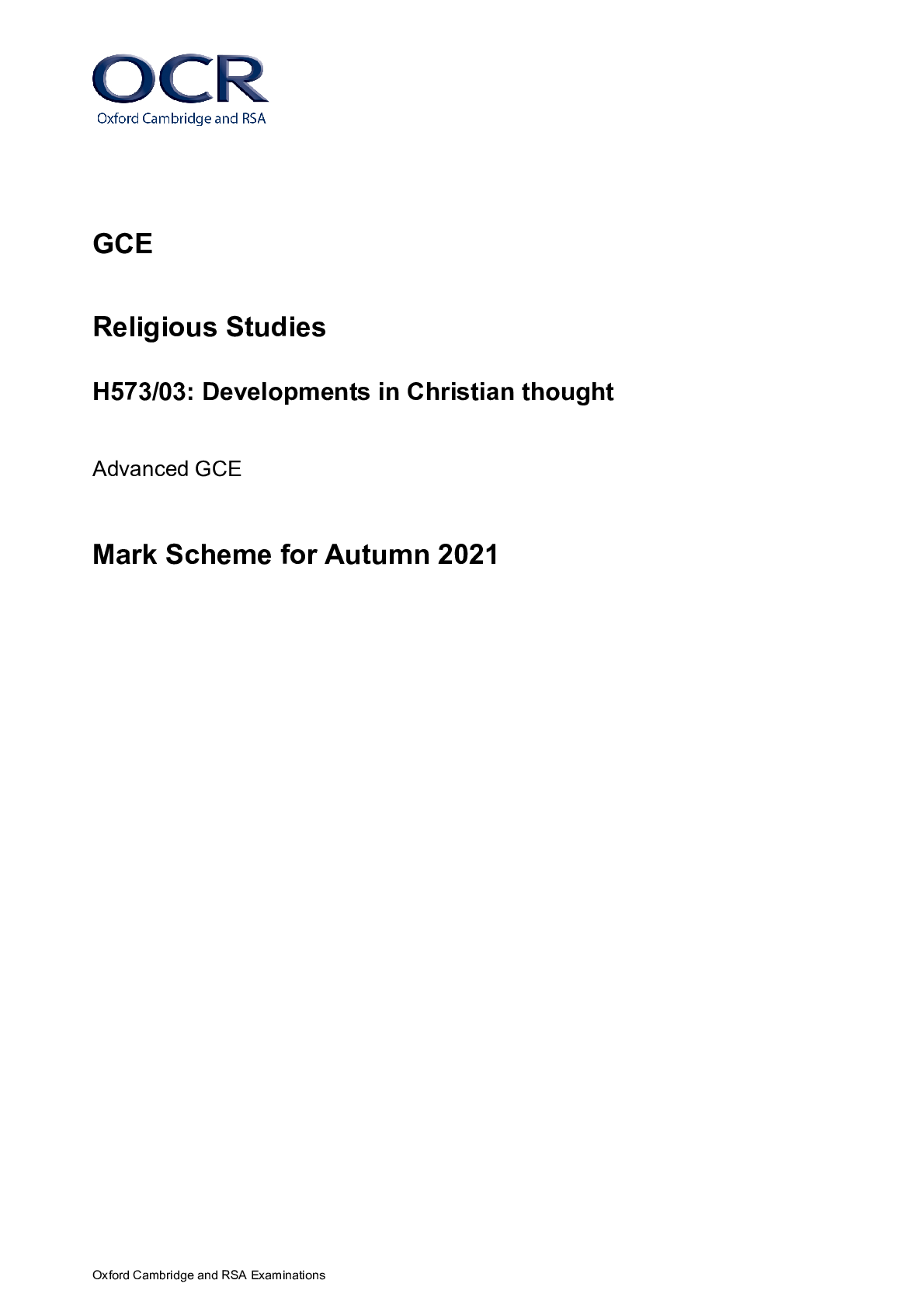
Buy this document to get the full access instantly
Instant Download Access after purchase
Add to cartInstant download
Reviews( 0 )
Document information
Connected school, study & course
About the document
Uploaded On
Oct 07, 2022
Number of pages
17
Written in
Additional information
This document has been written for:
Uploaded
Oct 07, 2022
Downloads
0
Views
39


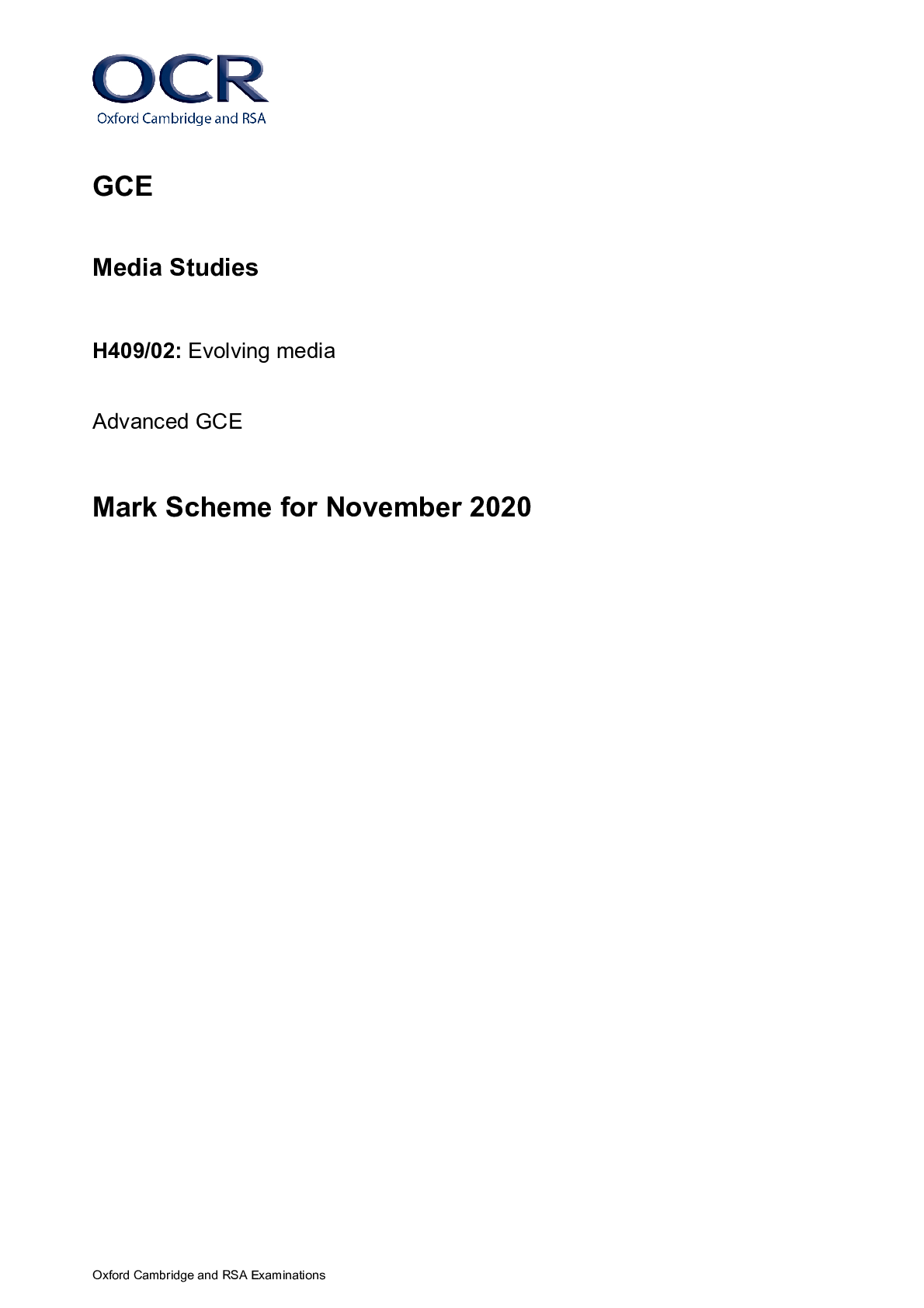
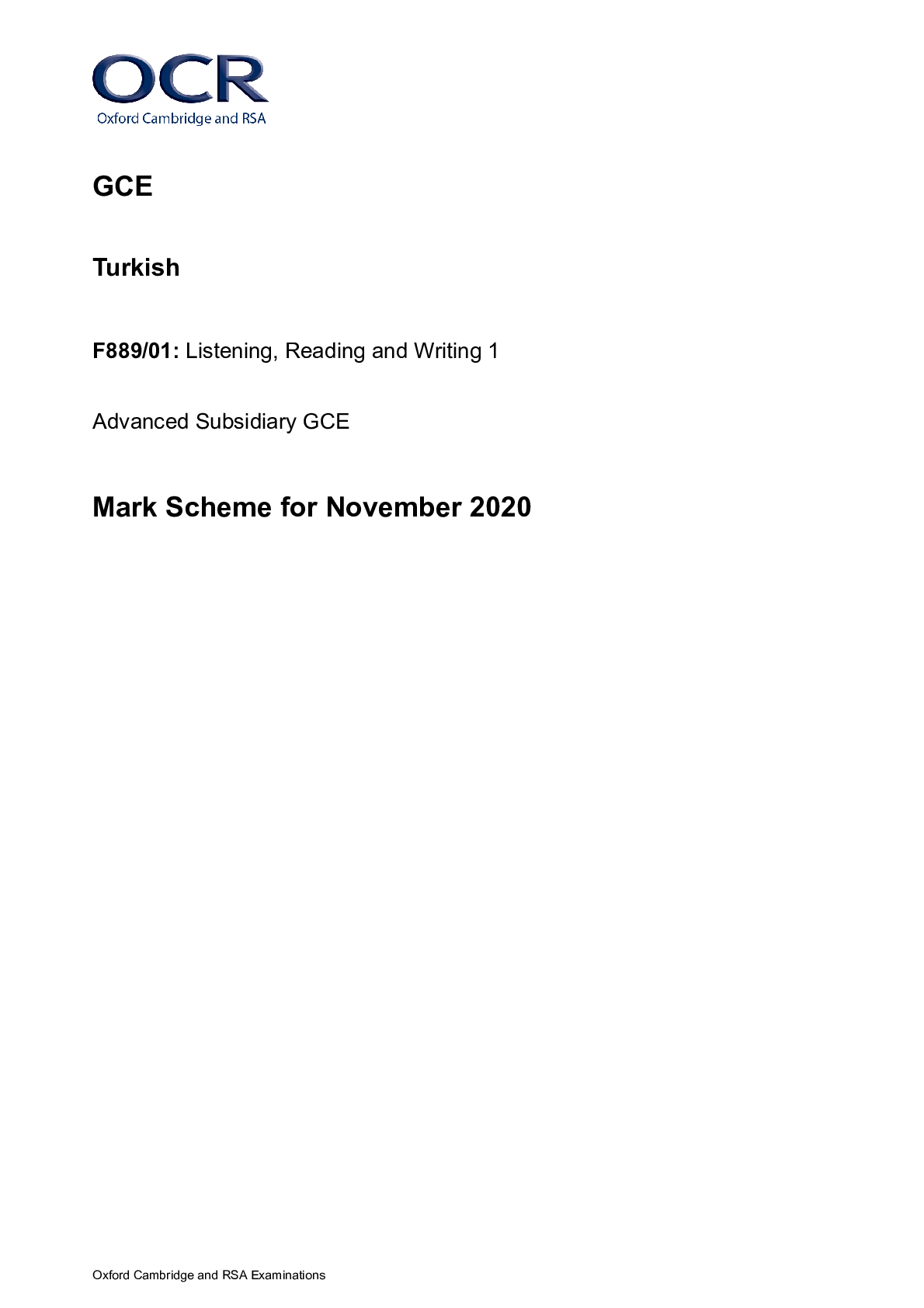
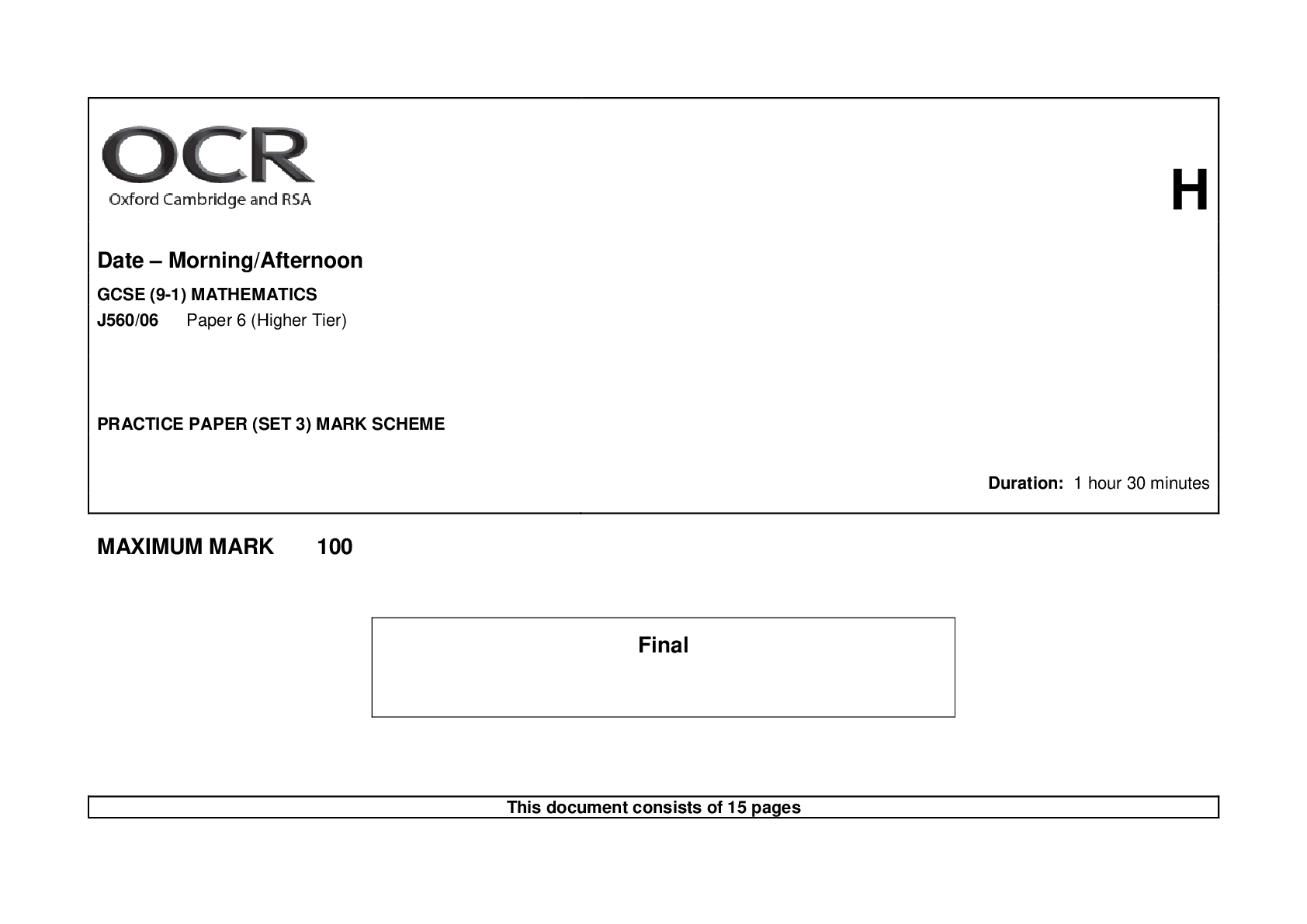


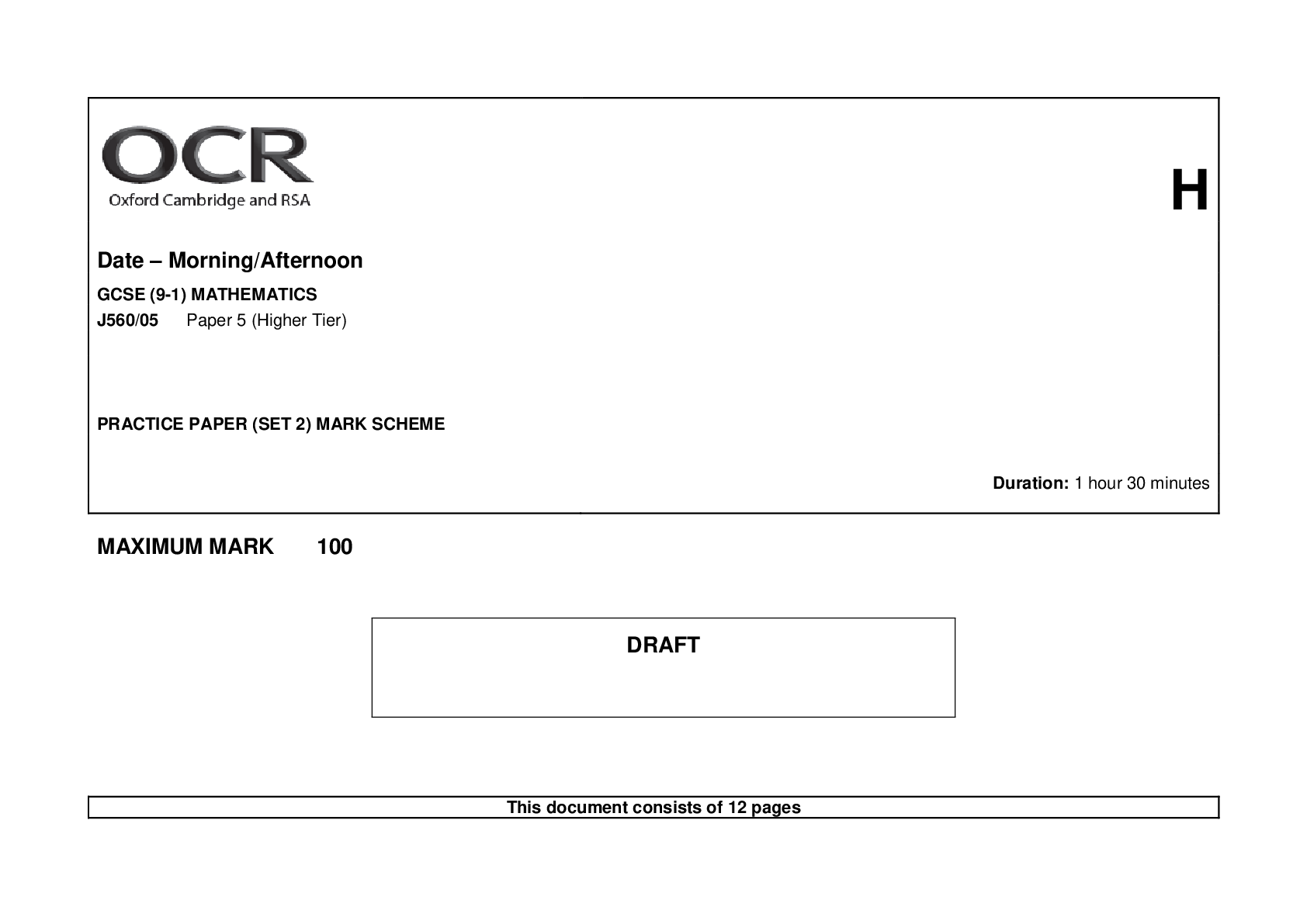
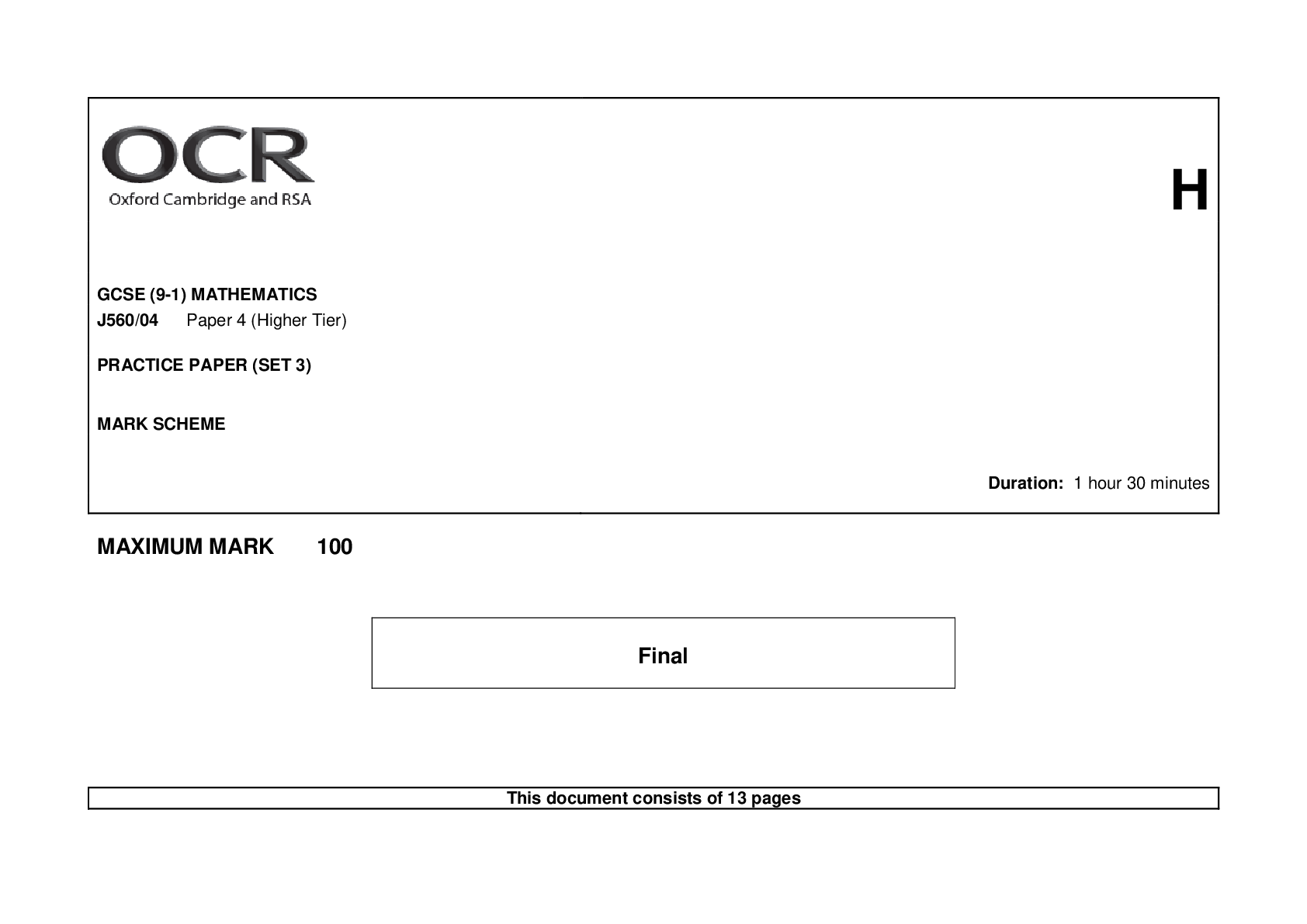



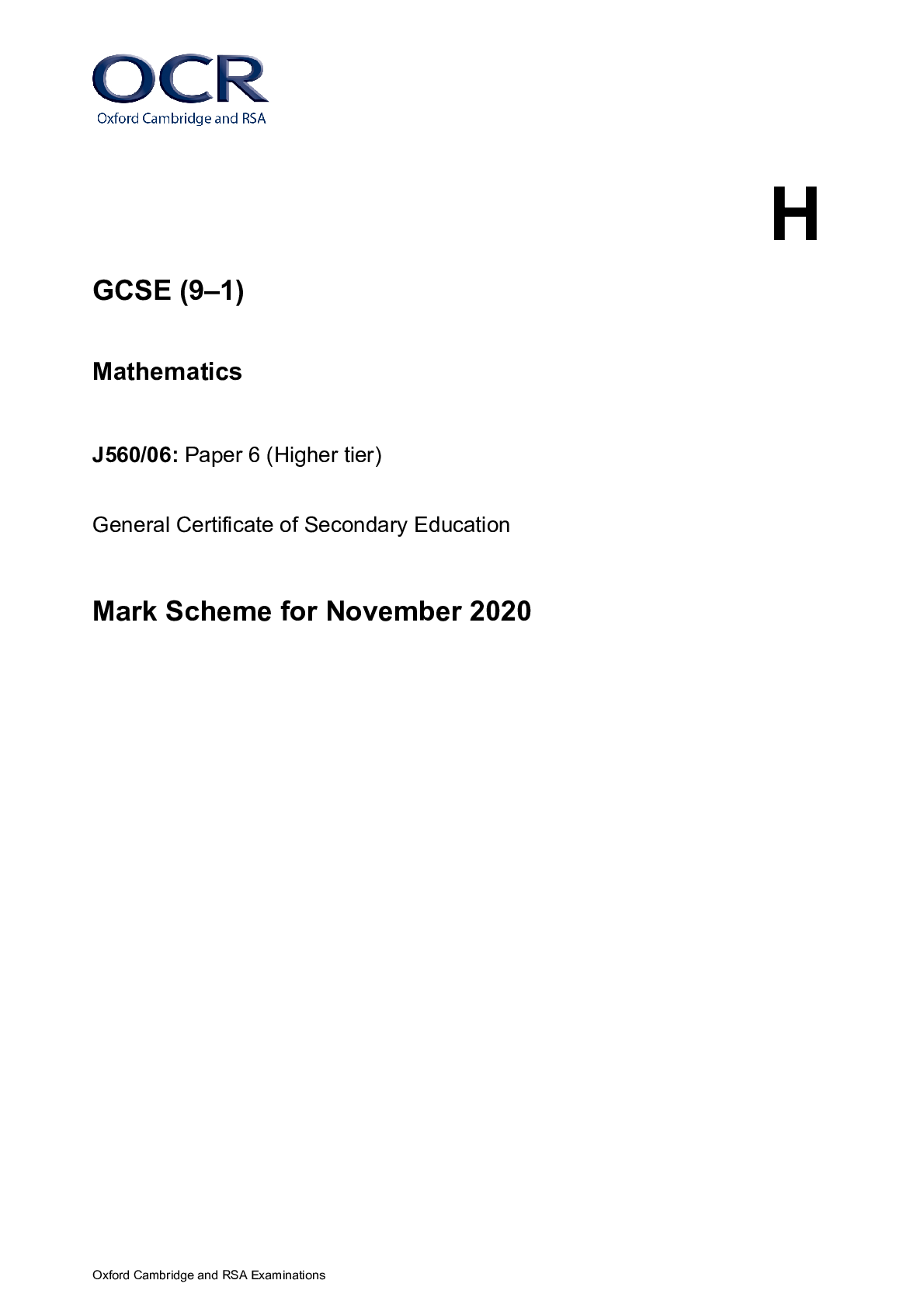
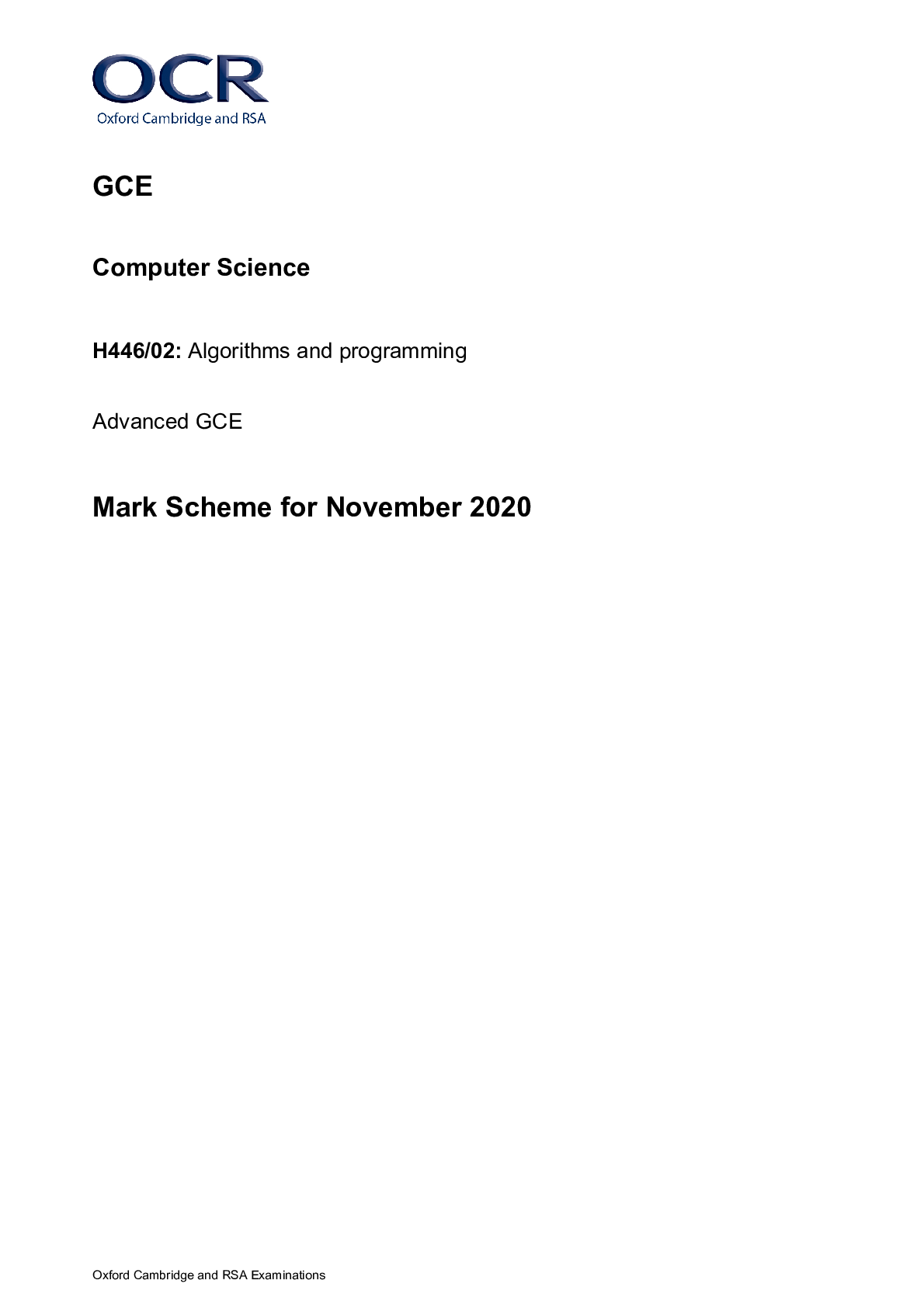
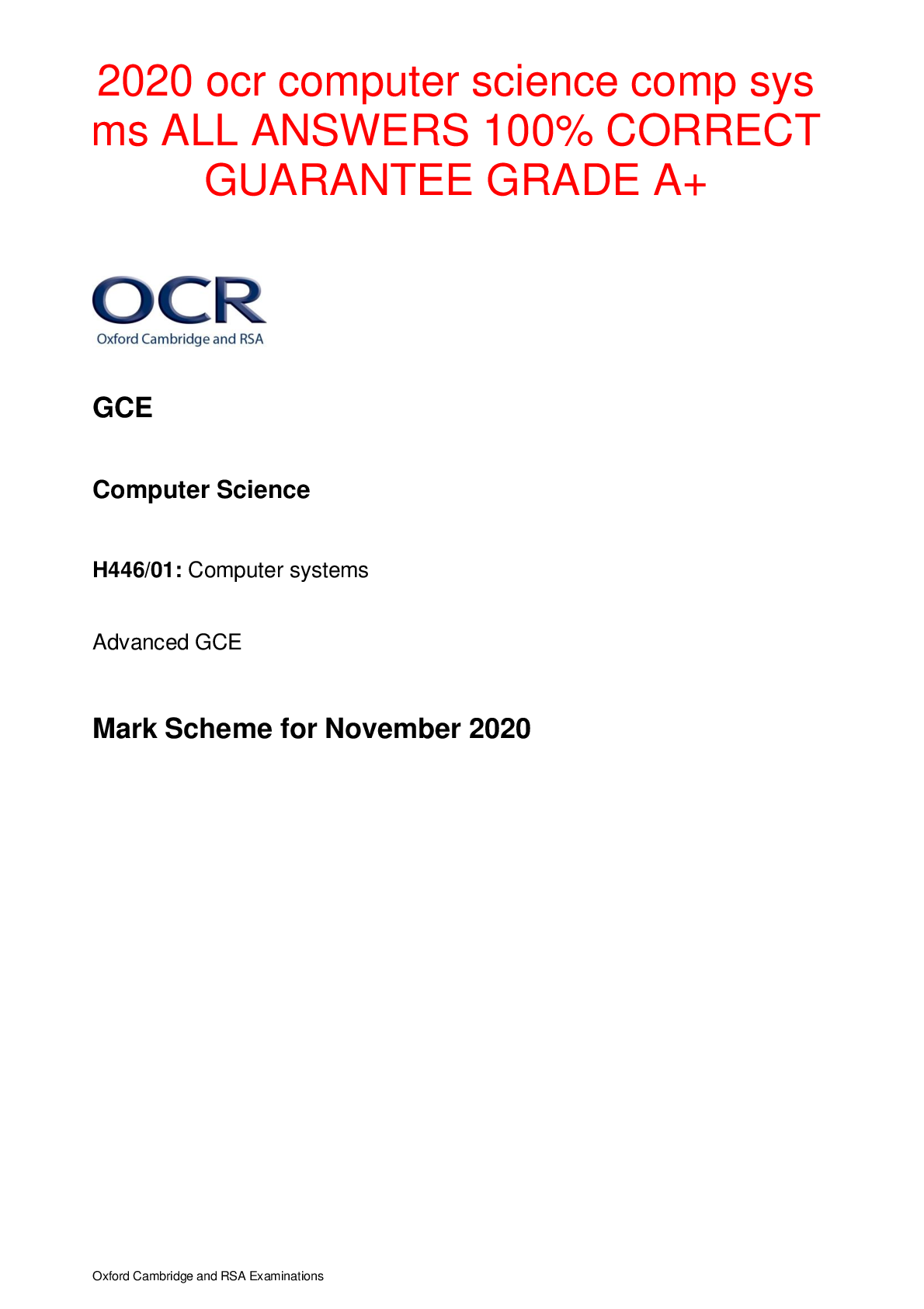

.png)
